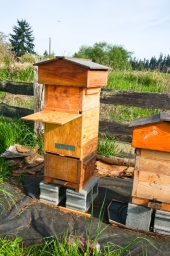
 1
1




Nothing ruins a neighborhood like paved roads and water lines.
 3
3




“Birds born in a cage think flying is an illness.” ― Alejandro Jodorowsky
 4
4




Mark Reed wrote:I figure the bottom two boxes which I guess can be thought of as deeps and where the hive will basically live are fie as they are. So, to start out, do I really need both of the top, supers or can I get by with just one for now?
find religion! church
kiva! hyvä! iloinen! pikkumaatila
get stung! beehives
be hospitable! host-a-hive
be antisocial! facespace
 2
2




Nothing ruins a neighborhood like paved roads and water lines.
 2
2




Nothing ruins a neighborhood like paved roads and water lines.

 1
1




Mark Reed wrote:One thing is I had read that they brood down low and store honey above. That didn't really make sense to me because when they move into an empty tree it just makes sense they start at the top.
find religion! church
kiva! hyvä! iloinen! pikkumaatila
get stung! beehives
be hospitable! host-a-hive
be antisocial! facespace
 2
2




Nothing ruins a neighborhood like paved roads and water lines.
 6
6




Nothing ruins a neighborhood like paved roads and water lines.

 4
4




find religion! church
kiva! hyvä! iloinen! pikkumaatila
get stung! beehives
be hospitable! host-a-hive
be antisocial! facespace
 1
1




Nothing ruins a neighborhood like paved roads and water lines.




 2
2




Nothing ruins a neighborhood like paved roads and water lines.





|
Spare the rod, spoil the child. Here, use this tiny ad named Rod:
The new permaculture playing cards kickstarter is now live!
https://www.kickstarter.com/projects/paulwheaton/garden-cards
|





